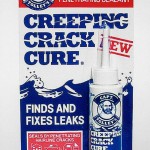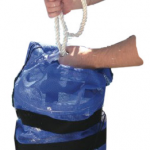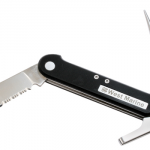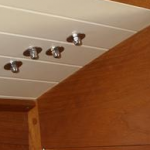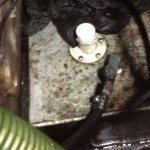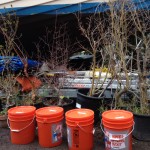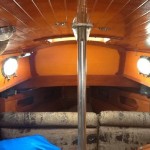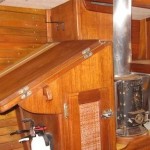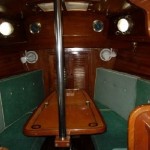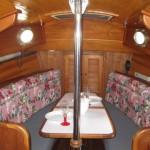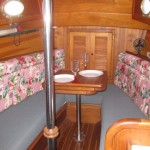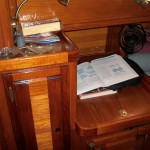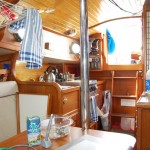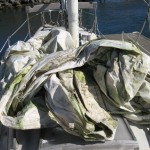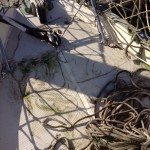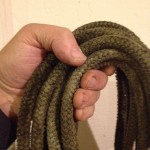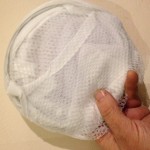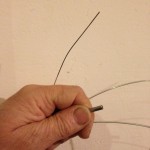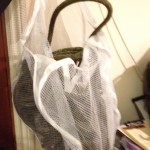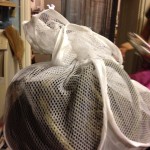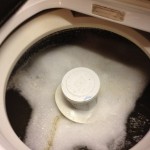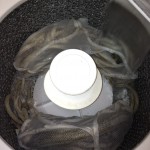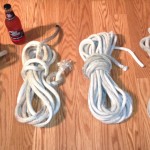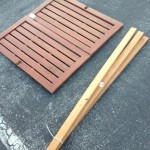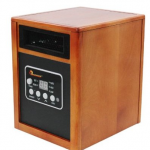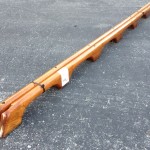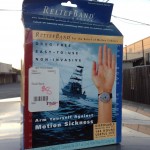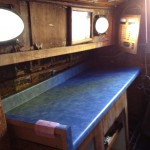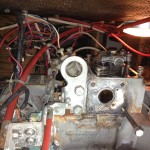
Looking forward at the Yanmar SB-8 from the aft (transmission) side. Large loop is the engine lift/throttle mount. To the right the exhaust port of the cylinder head is visible with one bolt in place to keep the oil in. In the background, a rat’s nest of wires that will need some attention.
I spent almost four hours on the motor on Wednesday. The level of the automatic transmission fluid I was using to soak the cylinder had not dropped much, so I decided to proceed with the head removal. After much effort I was able to get the cylinder head off. The throttle linkage mounts to the head, so that had to be removed with two large bolts. The 1/2 drive metric sockets I picked up yesterday at Harbor Freight came in handy for this.
I was able to separate the head gasket and slowly work in a small wood shim between the head and engine. It didn’t want to go further. As it turns out, there was some significant rust on a pair of the studs that made the fit very difficult. It took an hour to pry the head off, working bit by bit from three sides of the engine, even though all the fasteners were removed. I was concerned that the clearance between the top of the studs and the cylinder head, which still had the injector installed, wouldn’t give me space to remove the head because the cockpit is directly above. Luckily it cleared by a fraction of an inch in a very particular orientation I hope I can remember if I reinstall it later.
The exhaust valve looks and operates fine, but the intake valve was siezed, and even tapping on it with a wood block did not allow it to move. The corresponding pushrod was also rusty.
Disaster! When I put one of the pushrods back in the engine block I must have missed the rod channel and dropped it right into one of the oil passages. This necessitated removing the oilpan, which is held on by nine 10mm bolts. I began by draining the sump, and was surprised to find about 8 ounces of water at the bottom of the bilge. That pretty much explains all the problems with the engine. The water and goey tarball oil went right into the bilge to join the diesel already there. The pan came off fairly easily after breaking the bolts loose with a small 10mm box wrench. The cheapie 1/4″ drive socket broke off on the first one.
Inside the bilge I found another half cup of oily goo and the errant pushrod, which had fallen straight through. I cleaned off the underside of the engine, and felt the oil pickup and the bottom of the dipstick, which is a very odd texture if you’re not expecting it… felt like a big tye wrap hanging down. Nothing I could reach seemed rusty, though. Oil pickup tube and the bottom of the crank. I expect the problems now are in the middle front areas, where the water and diesel pumps are.
Next, I tried to remove the water pump, but 1 of the three 10mm screws was very corroded and will require vice grips and a prayer. The others came straight out. A project for later this week!
At this point I am expecting I will need a new engine, and the Yanmar 2GM-20F looks like a good bet. That model is a 15HP twin-cylinder, freshwater-cooled engine. I would benefit from both the added horsepower and the freshwater cooling, which would actually permit the use of the water heater I already have, if I can find a place for it.
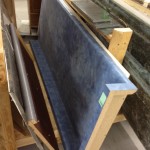
a 5-foot section of blue formica I found at Restore in San Carlos for $20. A little dusty, but vaguely nautical.
I picked up two boxes of 4″ slate tile at the restore center to evaluate for the furnace area. I also bought a 5′ section of sea-blue formica for $20 for the galley. I don’t know if this is the final counter, but I figured it would be best to make all my mistakes with an inexpensive piece of material (Like getting it up the ladder, through the companionway and onto the table surface isn’t an adventure in itself.)
Oh – I didn’t like that tile much. I packed it up to return on Thursday.

